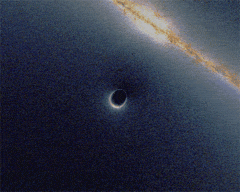Can we identify black holes in our path flying between the stars?
When traveling at fast speeds through the galaxy, would it be possible to identify where all the black holes were on your path? I know most black holes are identified by their affect on other nearby objects. But what would happen if it was all by its lonesome?
Would we be able to 'sense' it somehow before getting to close to be adversely affected by it? Or would we fly by, maybe getting close enough for it to deflects our course? And how much could it deflect a course (assuming you stay out of the event horizon)? Would it warping of space allow for Alcubierre drive like properties?
I guess I'd hate to get thrown into a sun because of a course alteration from a black hole, though getting caught in the event horizon wouldn't be much better. Can we detect these masses to avoid them at distance or do we need to take first trips much slower so we can scan for these anomalies and mark them for safe 'shipping lanes'?
This post was sourced from https://worldbuilding.stackexchange.com/q/5262. It is licensed under CC BY-SA 3.0.
2 answers
You are accessing this answer with a direct link, so it's being shown above all other answers regardless of its score. You can return to the normal view.
Another idea: Black holes shadow the cosmic microwave background. This might be used to detect them. Given that with high speeds, the microwave background in movement direction (that's the direction that's relevant if you want to avoid them) will be at higher frequencies due to the Doppler effect, I can imagine detecting them by their shadowing would be simplified.
0 comment threads
Barring the presence of an accretion disk surrounding these black holes - unlikely, in the absence of a compansion object - our best bet is likely to exploit gravitational lensing, the bending of light from distant objects by a massive object in front of the source. Typically, the massive object is a foreground galaxy, a massive star, or - in this case - a black hole.
The angle of the light bent can be calculated as
We have yet to detect lensing from an isolated, low-mass black hole, but it's not out of the question. If we did see it, it might look like this:

Image credit: Wikipedia user Urbane Legend, CC BY-SA 3.0




















0 comment threads